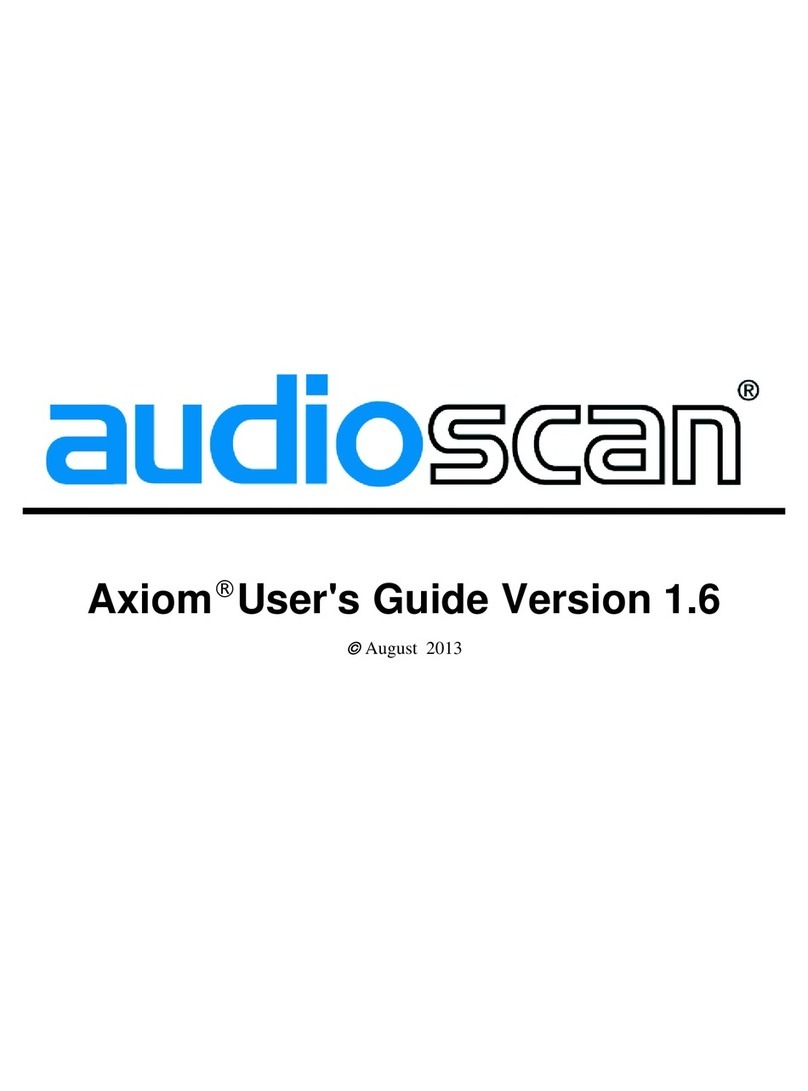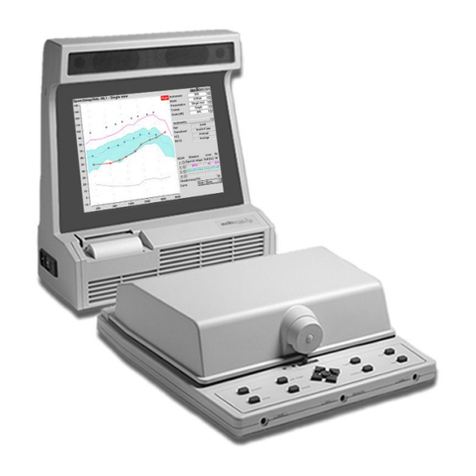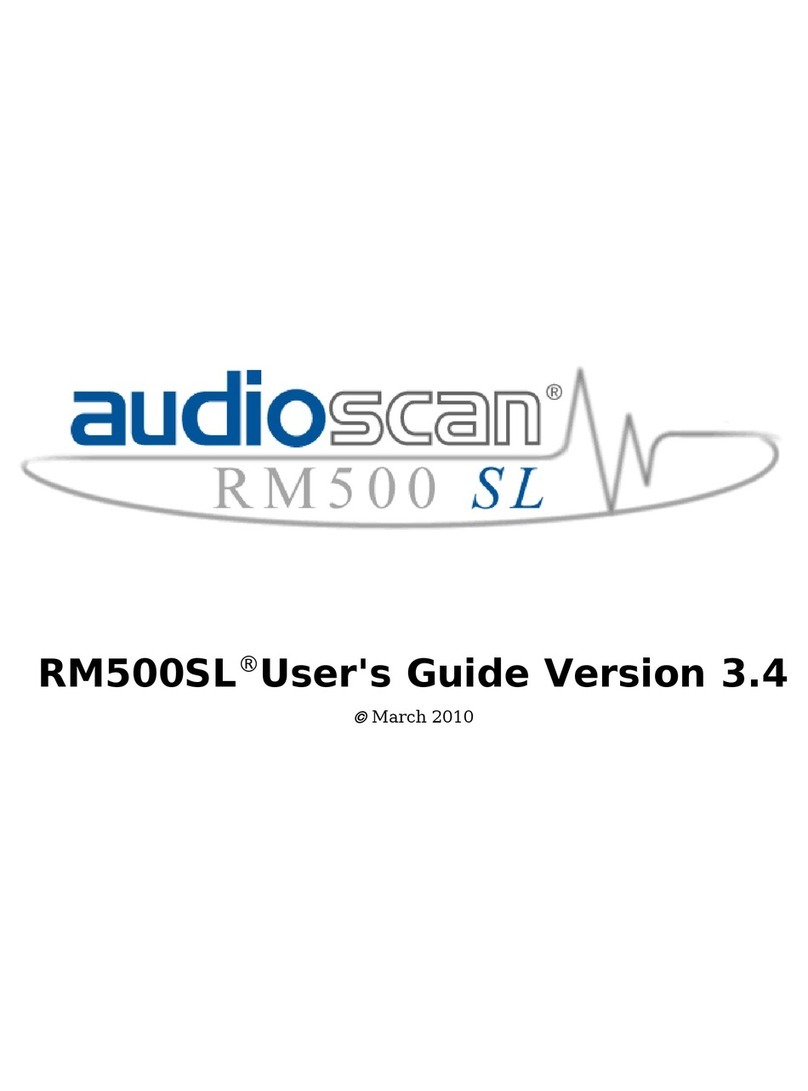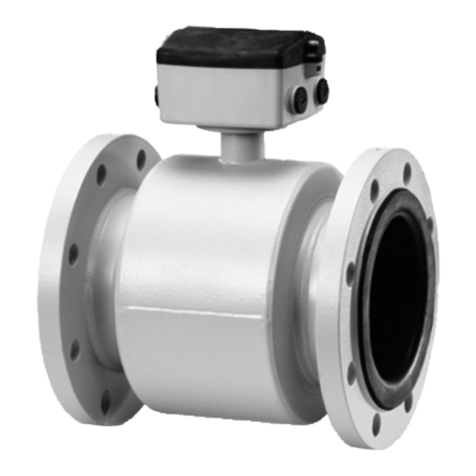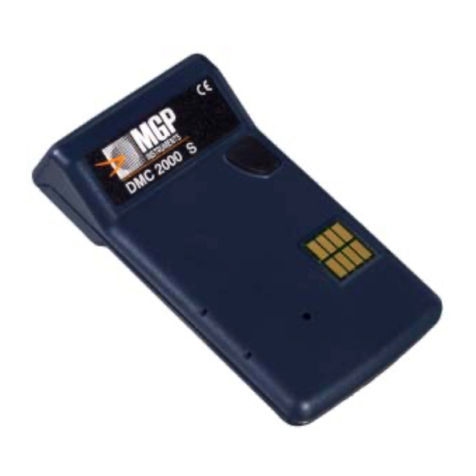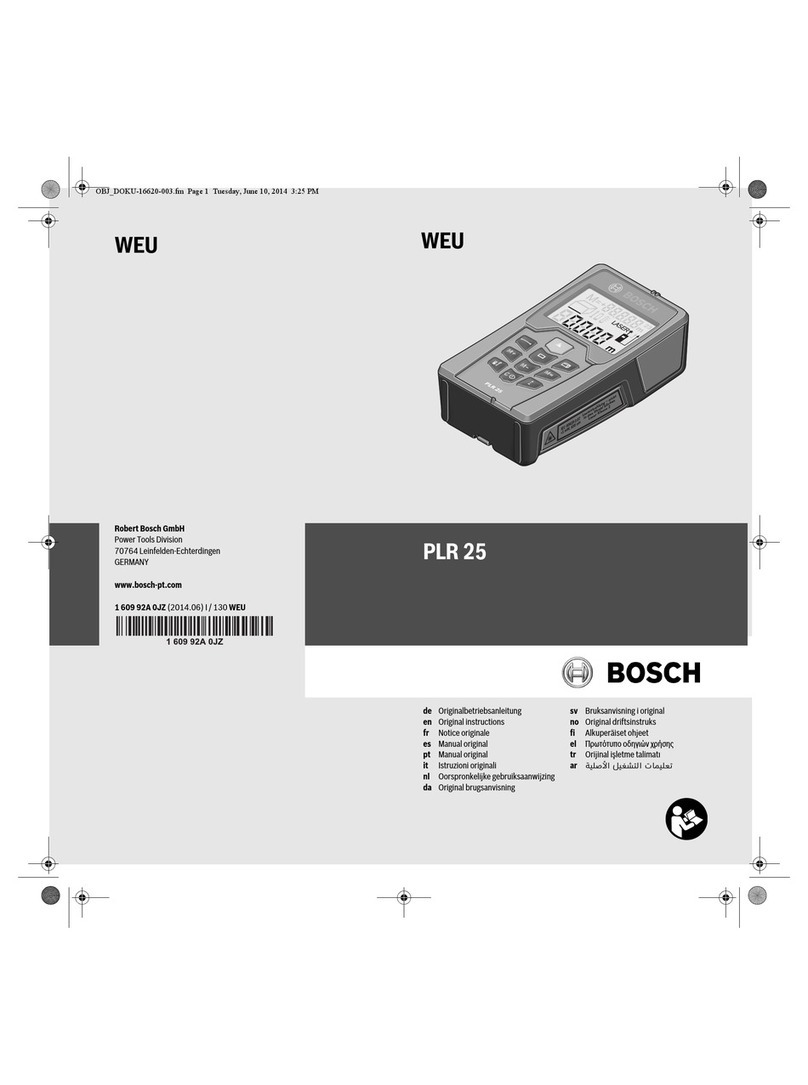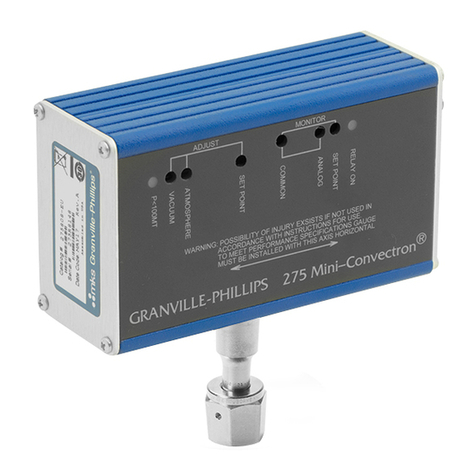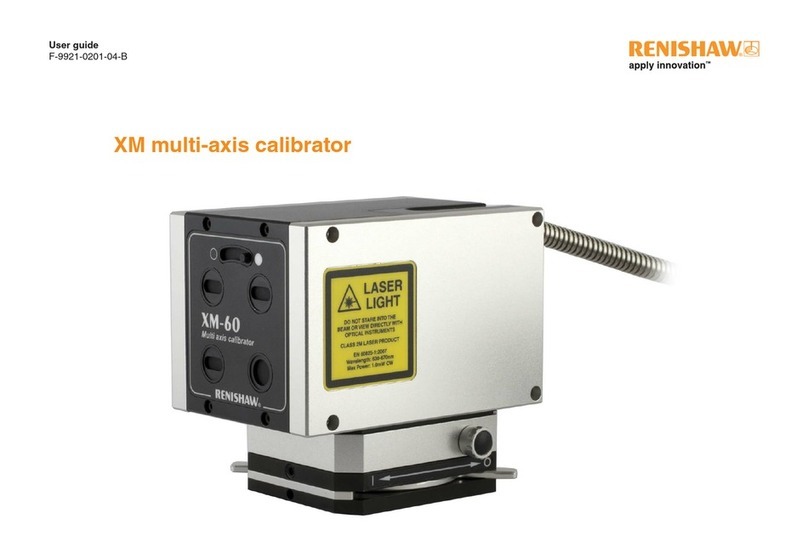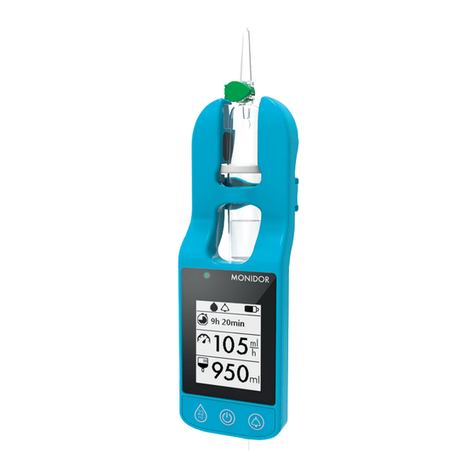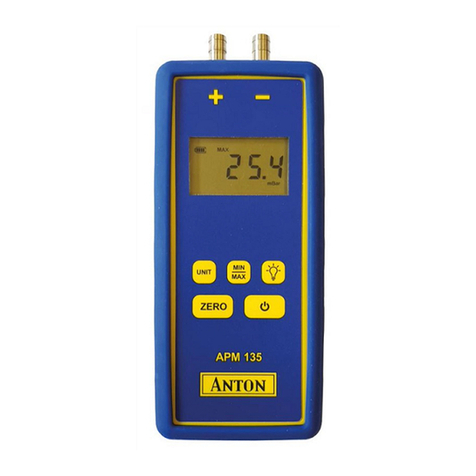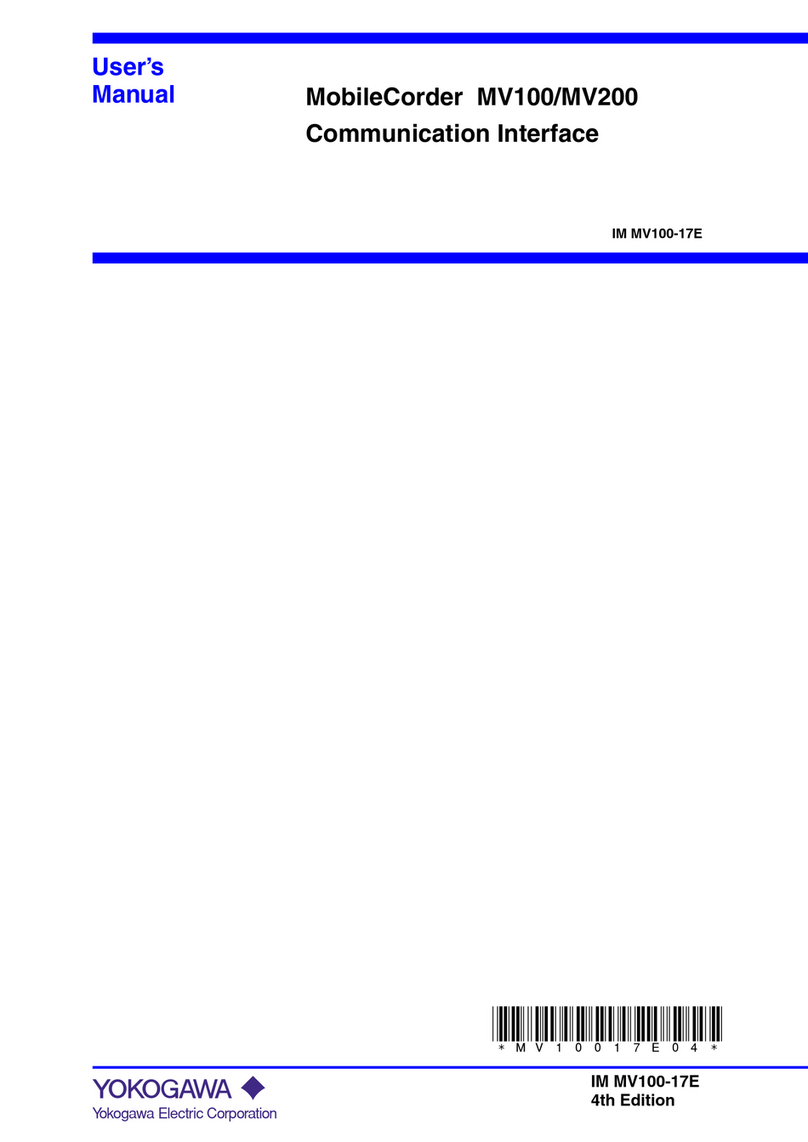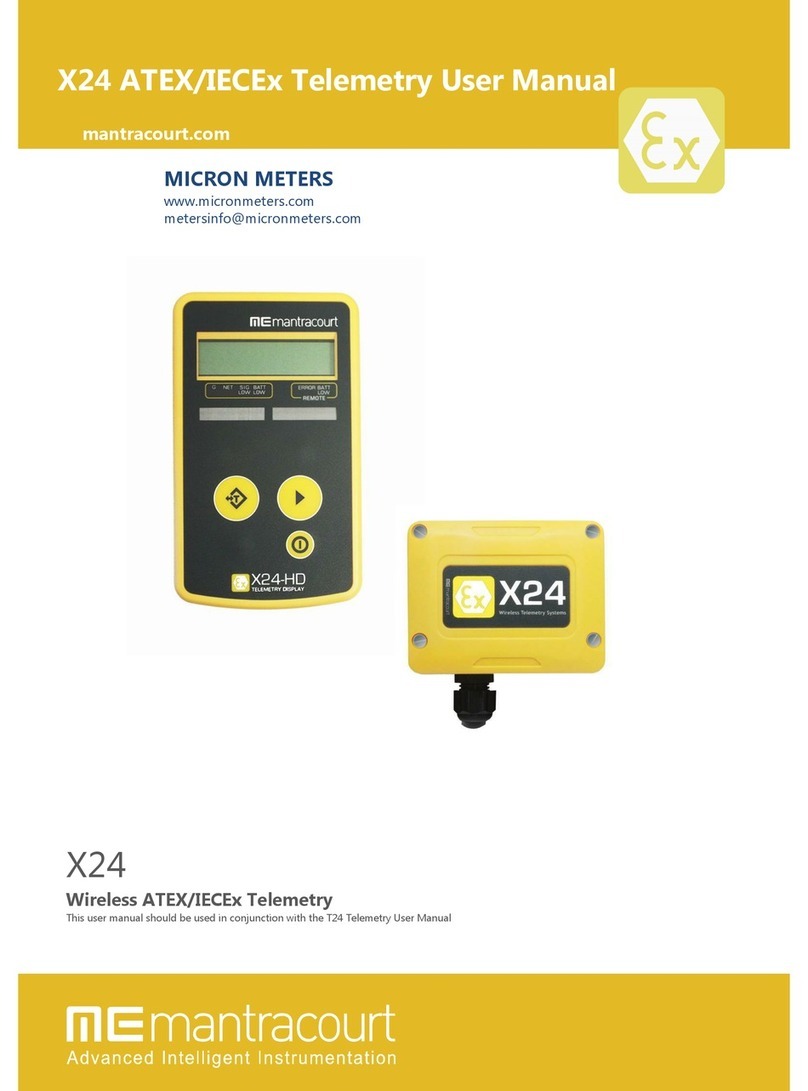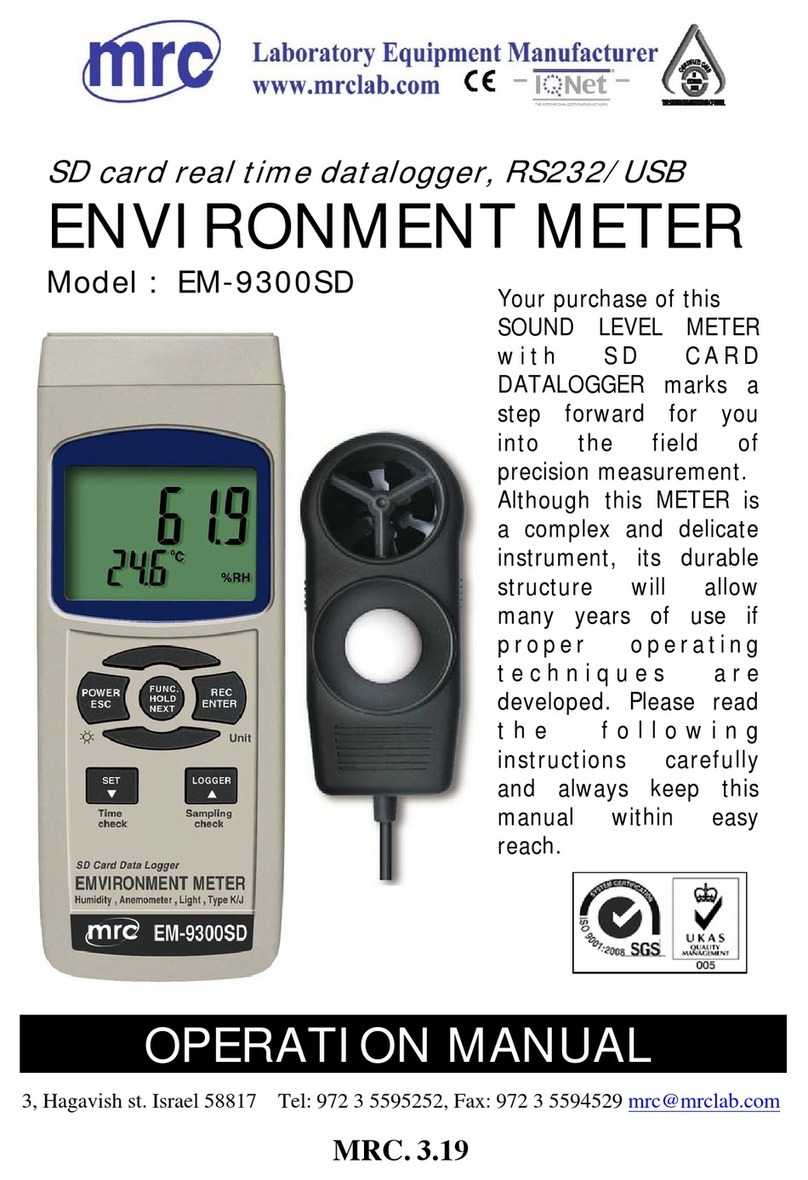audioscan Verifit VF-1 User manual

Audioscan Verifit®
User's Guide 3.12
November 2015

Table of Contents
1 About Verifit..........................................................................................................................................................................6
New in this software release................................................................................................................................................6
Product description...............................................................................................................................................................6
Associated items and supplies..............................................................................................................................................7
AFETY WARNING and NOTICE ................................................................................................................................7
Environmental safety............................................................................................................................................................9
Declaration of Electromagnetic Compatibility (EMC).......................................................................................................9
Warranty, Trademarks, Acknowledgments.......................................................................................................................10
EC Declaration of Conformity...........................................................................................................................................11
Electronic User’s Guide.....................................................................................................................................................12
How to Avoid Undesirable ide Effects............................................................................................................................12
2 Getting tarted.....................................................................................................................................................................14
Unpacking and connecting.................................................................................................................................................14
Microphone connection......................................................................................................................................................15
General care instructions....................................................................................................................................................16
Microphone care.................................................................................................................................................................16
Battery pill use and care.....................................................................................................................................................17
Mouse, keyboard, barcode scanner....................................................................................................................................18
Monitor headphones...........................................................................................................................................................18
External peripherals............................................................................................................................................................19
3 General Operation................................................................................................................................................................21
Input device operation........................................................................................................................................................21
Barcode data input..............................................................................................................................................................21
Keypad keys........................................................................................................................................................................22
Menus, lists and buttons.....................................................................................................................................................23
creen messages and Help.................................................................................................................................................23
oftware updating...............................................................................................................................................................24
4 General etup.......................................................................................................................................................................25
Date and time setup............................................................................................................................................................25
Display settings...................................................................................................................................................................25
aving test setup.................................................................................................................................................................25
5 Networking...........................................................................................................................................................................27
Networking requirements...................................................................................................................................................27
Networking setup................................................................................................................................................................27
NOAH ervice Port............................................................................................................................................................28
Changing the NOAH service port......................................................................................................................................28
Testing the NOAH service port..........................................................................................................................................29
6 ingle computer connection................................................................................................................................................30
Automatic connection (recommended)..............................................................................................................................30
tatic connection................................................................................................................................................................30
7 Printing and toring Results................................................................................................................................................32
Internal printer paper loading.............................................................................................................................................32
Barcodes, tabular data, headers and comments on printouts............................................................................................33
Local printer setup..............................................................................................................................................................34
Printing to U B memory....................................................................................................................................................34
Network printer setup.........................................................................................................................................................35
Printing to a network file....................................................................................................................................................35
toring and restoring data – setup......................................................................................................................................36
toring and restoring data..................................................................................................................................................37
Data storage using NOAH..................................................................................................................................................38
8 Test Box Measures - etup..................................................................................................................................................39
Test box screen...................................................................................................................................................................39
Format.................................................................................................................................................................................40
cale....................................................................................................................................................................................40
Hide or how test box curves.............................................................................................................................................40
1996 or 2003 AN I standard..............................................................................................................................................40

Verifit®User's Guide Version 3.12
November 2015
AN I test frequencies.........................................................................................................................................................41
Test box calibration facts...................................................................................................................................................41
Calibrating test box reference microphone........................................................................................................................42
Calibration check for coupler microphone........................................................................................................................43
Coupling the hearing instrument for AN I tests...............................................................................................................44
Coupling the hearing instrument for Test box peechmap...............................................................................................44
Positioning the hearing instrument....................................................................................................................................45
9 AN I Hearing Aid Tests......................................................................................................................................................47
AN I 3.22-1996 facts.......................................................................................................................................................47
AN I 3.22-2003 facts.......................................................................................................................................................47
AN I 1996 Linear and AGC tests......................................................................................................................................48
AN I 2003 Linear and AGC tests......................................................................................................................................48
AN I test results.................................................................................................................................................................49
AN I input-output curves..................................................................................................................................................49
AN I telecoil terminology.................................................................................................................................................50
AN I telephone simulator (TMF ) test.............................................................................................................................51
AN I test loop test..............................................................................................................................................................52
Telecoil test results.............................................................................................................................................................52
10 Other Test Box Measures..................................................................................................................................................54
Harmonic distortion............................................................................................................................................................54
Noise reduction...................................................................................................................................................................54
Feedback suppression test..................................................................................................................................................55
Directional function test.....................................................................................................................................................56
Directional ITE positioning................................................................................................................................................57
Directional BTE positioning..............................................................................................................................................57
Test box directional procedure...........................................................................................................................................58
Multicurve procedure.........................................................................................................................................................59
Multicurve results...............................................................................................................................................................59
pectral analysis in Multicurve..........................................................................................................................................60
Battery drain test................................................................................................................................................................60
Manual control procedure..................................................................................................................................................61
ound level meter using manual control...........................................................................................................................62
11 ensory loss simulator.......................................................................................................................................................64
ensory loss simulator description.....................................................................................................................................64
ensory loss simulator operation.......................................................................................................................................64
12 On-Ear Measures - etup...................................................................................................................................................65
External sound-field speaker setup....................................................................................................................................65
On-ear calibration facts......................................................................................................................................................65
Calibration of on-ear probe microphone............................................................................................................................66
Calibration check for probe module..................................................................................................................................67
Max TM PL setup............................................................................................................................................................68
ABR nHL to eHL setup......................................................................................................................................................69
Positioning the client..........................................................................................................................................................69
Positioning the probe tube..................................................................................................................................................70
13 On-Ear Measures creen etup.........................................................................................................................................72
On-ear single or dual view.................................................................................................................................................72
Graph, table or 2cc target format.......................................................................................................................................73
PL or HL scale..................................................................................................................................................................73
Hide or show on-ear curves................................................................................................................................................73
14 On-Ear Instrument Measures.............................................................................................................................................75
On-ear directional test overview........................................................................................................................................75
On-ear directional testing...................................................................................................................................................75
3

Verifit®User's Guide Version 3.12
November 2015
On-ear feedback test...........................................................................................................................................................76
On-ear noise reduction test.................................................................................................................................................76
On-ear manual control........................................................................................................................................................77
ound level meter using on-ear microphones....................................................................................................................78
15 Occlusion Effect Test.........................................................................................................................................................80
Occlusion effect measurement...........................................................................................................................................80
16 RECD measurement...........................................................................................................................................................81
Calibration of RECD transducer........................................................................................................................................81
Measure RECD ..................................................................................................................................................................82
RECD results......................................................................................................................................................................83
AN I 3.46(2013) RECD .................................................................................................................................................84
RECD protocols..................................................................................................................................................................84
RECD facts.........................................................................................................................................................................86
17 Insertion Gain.....................................................................................................................................................................87
Insertion gain in PL..........................................................................................................................................................87
Insertion gain in HL...........................................................................................................................................................88
Audiometric data entry.......................................................................................................................................................88
REUR measurement procedure..........................................................................................................................................89
REAR measurement procedure..........................................................................................................................................90
II calculation in Insertion gain.........................................................................................................................................91
CRO fitting using Insertion gain......................................................................................................................................91
18 peechmap.........................................................................................................................................................................93
peechmap facts.................................................................................................................................................................93
D L 5.0 in peechmap.......................................................................................................................................................93
D L 5.0 changes.................................................................................................................................................................94
NAL-NL1 in peechmap....................................................................................................................................................94
NAL-NL2 in peechmap....................................................................................................................................................94
Camfit in peechmap.........................................................................................................................................................95
Using peechmap...............................................................................................................................................................95
peechmap etup................................................................................................................................................................96
creen tour - unaided screen..............................................................................................................................................97
creen tour - aided screen..................................................................................................................................................98
On-ear or Test box mode....................................................................................................................................................98
II calculation in peechmap.............................................................................................................................................99
Using custom stimuli in peechmap..................................................................................................................................99
Creating WAV files for peechmap................................................................................................................................101
19 peechmap Fitting Procedures........................................................................................................................................103
Assessment data entry......................................................................................................................................................103
Assessment data choices..................................................................................................................................................104
Fitting to targets for soft speech.......................................................................................................................................105
Fitting to targets for loud sounds.....................................................................................................................................106
Fitting to targets for mid-level speech.............................................................................................................................106
Open fittings in peechmap.............................................................................................................................................107
Verifying Frequency Compression/ Frequency-Lowering Hearing Instruments in peechmap....................................107
FM fitting and verification...............................................................................................................................................109
CRO fitting in peechmap.............................................................................................................................................110
T-Loop fitting and verification in peechmap................................................................................................................111
20 peechmap Technical Details..........................................................................................................................................114
peechmap stimuli...........................................................................................................................................................114
timulus levels..................................................................................................................................................................114
Microphone location effects.............................................................................................................................................115
Deep insertion compensation...........................................................................................................................................116
4

Verifit®User's Guide Version 3.12
November 2015
peech signal analysis......................................................................................................................................................116
21 Viewport...........................................................................................................................................................................117
Viewport setup..................................................................................................................................................................117
Accessing Viewport tests.................................................................................................................................................118
Viewport Audibility test...................................................................................................................................................118
Viewport Test box directional test...................................................................................................................................119
Viewport Test box feedback test......................................................................................................................................122
Viewport On-ear feedback test.........................................................................................................................................123
22 Troubleshooting...............................................................................................................................................................125
elf test failures................................................................................................................................................................125
Initialize Function............................................................................................................................................................125
Test box high distortion or noise......................................................................................................................................126
Test box curves inconsistent............................................................................................................................................126
Test box curves differ from specifications......................................................................................................................126
Test box speaker overdriven............................................................................................................................................127
No test box reference mic. detected.................................................................................................................................127
Invalid test box calibration...............................................................................................................................................127
No on-ear ref. mic. detected.............................................................................................................................................127
Invalid on-ear calibration.................................................................................................................................................128
ound-field speaker overdriven.......................................................................................................................................128
Invalid RECD transducer coupler calibration.................................................................................................................128
Invalid RECD real ear measurement...............................................................................................................................129
Barcode scanner malfunction...........................................................................................................................................129
23 Technical pecifications..................................................................................................................................................132
24 Glossary............................................................................................................................................................................135
25 References........................................................................................................................................................................140
26 Appendix 1.......................................................................................................................................................................143
Manufacturer Disclosure tatement for Medical Device ecurity.................................................................................143
27 Appendix 2.......................................................................................................................................................................146
AudioNote 2.1 VERIFIT and RM500 L Test ignals and Analysis..............................................................................146
5

Verifit®User's Guide Version 3.12
November 2015
1 About Verifit
This section provides a listing of features new in this software release, describes the Audioscan Verifit, provides
contact, warranty and trademark information, safety warnings and notices and instructions for accessing the
electronic User’s Guide.
Note that the User's Guide may be viewed on the Verifit at any time by pressing <Help>. (For long Help pages,
use <Left/Right> (or mouse) to switch between the Help index and the Help page and arrows (or mouse) to
scroll through the page).
New in this software release
oftware 3.12 introduces the following significant additions and changes:
1. NAL-NL2 prescription formula. For details, see 17. NAL-NL2 in peechmap.
2. User-supplied test signals. For details see 17. Using custom stimuli in peechmap
3. Inductive stimulus in peechmap for adjusting tcoils for use with room loops. For details see 18. T-Loop
fitting and verification in peechmap.
4. New Directional Test works with feedback cancelers and frequency-lowering devices.
5. Improved audioscan updater. U B memory sticks left plugged in will not interfere with startup.
Product description
The Verifit is a hearing aid analyzer intended to be used by hearing care professionals such as audiologists and
hearing aid specialists to verify the electro-acoustic performance of a hearing aid connected to a standard
earphone coupler or while worn on the ear of the end user. It consists of:
a) an acoustically-treated test chamber which houses a battery substitute (1.3 volt supply), 2 loudspeakers, a
reference microphone for controlling the signal from the loudspeakers, a standardized earphone coupler
connected to a measuring microphone for the purpose of measuring the sound level produced in the standard
coupler by a hearing aid and a custom keypad.
b) an analyzer/display unit housing a flat-panel video display, power supply, signal generation, measurement
and control electronics and two sound-field loudspeakers.
c) two real-ear measurement microphone assemblies, each housing a reference microphone for controlling the
signal from the sound-field speakers and a probe microphone connected to a thin silicone tube which may be
inserted into the ear canal for the purpose of measuring the sound level in the ear canal produced by a hearing
aid.
d) a miniature earphone used to measure the real-ear to coupler difference (RECD) useful in estimating the
sound level produced in an individual ear from measurements in the standard earphone coupler.
The analyzer attaches to the acoustic test chamber via two 15-conductor cables. The acoustic test chamber
provides connectors for the microphones used for controlling the stimulus and measuring the response. For HIT
mode, a reference microphone, coupler microphone and a battery simulator are normally connected via
connectors provided inside the acoustic test chamber. For REM mode, two probe modules – each containing a
reference microphone and a measurement microphone, and a real-ear to coupler difference (RECD) earphone
are normally connected via connectors situated on the front of the acoustic test chamber. A connector and
volume control for headphones, used to monitor coupler and probe microphone signals, are provided on the front
right side of the test chamber.
6

Verifit®User's Guide Version 3.12
November 2015
There are connectors on the rear of the main display unit for 4 U B devices (flash drives, a QWERTY keyboard,
mouse, printer, barcode scanner), external speakers, an external HDMI monitor and connection to a network
(LAN) (serial number 4671 and higher). Units with serial number below 4671 have connectors for 2 U B
devices, an external VGA monitor, parallel printer, external speakers, a local area network (LAN) and an
R 223 serial port (not supported in this version of software).
Electrical supply input requirement: 100 – 240 Vac 47 – 63 Hz 250VA
A hospital grade grounded outlet is required.
Associated ite s and supplies
VA-100 oft case for Verifit
VA-111 External speaker with folding stand and clips for microphone extension cables
VA-120 Barcode scanner for reading barcoded audiometric data on printouts from Audioscan analyzers
VA-131 Microphone extension cable (3') for use with Audioscan analyzers
VA-133 Microphone extension cable (10') for use with Audioscan analyzers
VA-201 NOAH® module allows a networked PC running NOAH to exchange data with Audioscan analyzers
RE201-25 Thermal printer paper for the internal printer in the Verifit
RE367-36 Probe microphone tubes for single patient use (36 per bag)
SAFETY WARNINGS and NOTICES
For purposes of IEC 60601-1, this product is Class I with Type BF applied parts. The applied parts are:
1.Pro e tu e
2.Foam eartip
3.Pro e microphone
This device complies with Part 15 of the FCC Rules. Operation is su ject to the following two conditions:
(1) this device may not cause harmful interference, and (2) this device must accept any interference
received, including interference that may cause undesired operation
This Class A digital apparatus complies with Canadian ICES-003
This symbol on the product is a WARNING describing a foreseen risk
WARNING: To avoid the risk of electrical shock, use only the power cord supplied with the Verifit and
connect it only to a grounded (protectively earthed) electrical outlet.
WARNING: To allow electrical power to be rapidly disconnected in the event of an emergency, position the
Verifit in an accessible location so that the power cord may be quickly disconnected.
7

Verifit®User's Guide Version 3.12
November 2015
WARNING: To avoid the risk of electrical shock, any line-powered peripheral equipment connected to this
product must comply with UL/IEC 60601-1 OR comply with UL or IEC and I O safety standards for such
equipment AND a) be operated from an isolating transformer complying with UL/IEC 60601-1 OR b) be kept
at least 1.8m (6 ft.) from the patient.
WARNING: This equipment is not suitable for use in an oxygen-rich environment or in the presence of
flammable anesthetic mixtures with air or with oxygen or nitrous oxide.
WARNING: To ensure proper operation of this product, no modification of this equipment is permitted
WARNING: Probe tubes are for single-patient use only. Care is required when sliding the probe tube into the
ear canal. Be careful not to advance the probe tube further into the ear canal when inserting an earmold or
custom hearing instrument into the ear or when inserting the foam tip into the ear
WARNING: Foam eartips are for single-patient use only
WARNING: To ensure that the operation of this product is not affected by EMC emissions from other
products, this product should not be used adjacent to or stacked on other equipment. If this is necessary, its
operation should be verified as normal in this configuration. Portable and mobile RF communications
equipment can affect the performance of this product
WARNING: To reduce the risk of contamination, hearing instruments should be clean before putty is applied
and putty should be replaced frequently
WARNING: The included magnet may effect some medical or electronic devices. Keep magnet at least 5cm
(2in.) from implantable devices and other magnetically sensitive devices.
WARNING: Keep magnet out of reach of children and pets. If a magnet is swallowed seek immediate
medical attention.
This symbol on the product is a WARNING describing a required action.
Use only an approved test box cable to connect the test box and the display unit.
The test box can only be connected to the display unit.
This symbol on the product is a WARNING that failure to follow instructions in this part of the User’s and/or
Quick tart Guides could place the operator or patient at risk.
Failure to follow the operating instructions for connecting to a network, a local printer, a barcode scanner, or a
keyboard, or an external monitor could place the operator at risk
Failure to follow the operating instructions for connecting the mouse, or the Audioscan update stick could
place the operator at risk
This symbol on the product means that the parts applied to the patient meet the safety requirements of IEC
60601-1 for type BF isolated (floating) applied parts
8

Verifit®User's Guide Version 3.12
November 2015
Environ ental safety
This symbol on the product means that this product is not to be disposed of in unsorted municipal waste
because electrical and electronic waste may contain hazardous substances which could endanger the
environment and human health.
This product and its associated items must be disposed of in accordance with local disposal regulations for electrical
and electronic waste. Consult your local waste disposal authority regarding applicable regulations.
The microphone probe tubes and the foam eartips used with the RECD transducer are for single patient use. After use,
they may be disposed of in unsorted municipal waste or as required by your facility's waste management policy.
Declaration of Electro agnetic Co patibility (EMC)
Medical electrical equipment needs special precautions regarding EMC and needs to be installed and put into
service according to the following information:
•The Verifit should not be used adjacent to or stacked on other equipment. If this is necessary, its operation
should be verified as normal in this configuration.
•Portable and mobile RF communications equipment can affect medical electrical equipment and may affect
the performance of the Verifit.
•Performance degradation due to electromagnetic disturbances (including electrostatic discharge) is
considered normal and acceptable
The compliances listed in the following table are met with the supplied RECD transducer, microphones,
headphones, mouse and keyboard connected and with unterminated speaker cables (2), U B cables (2), Ethernet
cable, parallel printer cable, serial cable and VGA display cable connected. The connection of other devices
may result in increased emissions.
Guidance and manufacturer’s declaration - electromagnetic emissions
The Verifit is intended for use in the electromagnetic environment specified below. The user of the Verifit should
assure that it is used in such an environment.
Emissions test Compliance Electromagnetic environment - guidance
RF emissions
CI PR 11 Group 1
The Verifit uses RF energy only for internal function.
Therefore RF emissions are very low and not likely to
cause any interference in nearby electronic equipment.
RF emissions
CI PR 11 Class A
Harmonic emissions
IEC 61000-3-2 Class A
Voltage fluctuations/ flicker
emissions
IEC 61000-3-3
Complies
The Verifit is suitable for use in all establishments
other than domestic and those directly connected to
the public low-voltage power supply network that
supplies buildings used for domestic purposes.
9

Verifit®User's Guide Version 3.12
November 2015
Warranty, Trade arks, Acknowledg ents
The Audioscan Verifit is manufactured by Etymonic Design Inc., 20 Ludwig t., Dorchester, Ontario, Canada,
N0L 1G4. Web site www.audioscan.com.
Phone: 800-265-2093 (U A only); 519-268-3313 Fax: 519-268-3256
Email: info@audioscan.com or service@audioscan.com
The authorized representative for this product in the European Community is:
P.C. Werth, Audiology House, 45 Nightingale Lane, London, UK, W12 8 P.
Phone: +44 (0) 181-675 5151 Fax +44 (0) 181-675 7577.
Warranty: The Verifit is warranted against defects for two years from date of purchase. Within this period, it
will be repaired without charge for parts, labor or return shipping when returned prepaid to your authorized
Audioscan service agent. This warranty does not apply to equipment that, in our sole judgment, has been subject
to misuse, or unauthorized alteration or repair.
This warranty does not apply to battery substitutes (pills), which carry a 90 day warranty. This warranty does not
cover battery substitutes used in a hearing aid manufacturing facility.
Trademarks:
Audioscan, Axiom, peechmap, Verifit and Viewport, are registered trademarks of Etymonic Design Inc. D L
is a registered trademark of the University of Western Ontario. All rights reserved. HP LA ERJET is a
registered trademark of Hewlett-Packard Company. NOAH is a registered trademark of the Hearing Instrument
Manufacturer's oftware Association. QUE T is a trademark of Quest Technologies Inc. Post cript is a
registered trademark of Adobe ystems, Inc.
Acknowledgments:
D L 5.0 is used under license from the University of Western Ontario (UWO) which is solely responsible for its
content. We acknowledge the support received from past and present staff at the National Centre for Audiology
at UWO in implementing the D L method.
CAMFIT is used under license from Prof. Brian C.J. Moore, University of Cambridge, UK. We are indebted to
the University of Memphis Hearing Aid Research Laboratory for permission to use some of their recorded
speech material.
NAL-NL1 is used under license from the National Acoustics Laboratories, Australia.
NAL-NL2 is used under license from Hearworks Pty Ltd, Australia.
Software licenses:
Audioscan distributes selected software components under various open source licenses. These licenses
generally give you the right to copy and change the affected component's software source code. For details, see
the license files distributed with the software, or contact Audioscan.
10

Verifit®User's Guide Version 3.12
November 2015
EC Declaration of Confor ity
11

Verifit®User's Guide Version 3.12
November 2015
Electronic User’s Guide
Failure to follow operating instructions could place the user or operator at risk.
You can download the current User's Guide directly from www. udiosc n.com. A printable User's Guide is also
provided with each new instrument and each software update. A .pdf file viewer, such as Acrobat Reader (5.0
or higher) or Foxit Reader is required to view the User’s Guide. Except for some additional reference material,
the information in the User's Guide is available to you at any time by pressing <Help> on the Verifit.
If your Verifit does not have a built-in CD drive (serial number 4671 and higher), a printable User’s Guide is on
the updater U B flash drive supplied with the instrument. This User's Guide will be updated each time you
download new software from www. udiosc n.com to the updater U B flash drive.
To view the User's Guide:
1. Insert the updater U B flash drive into a U B port on your PC.
2. If your PC does not open the flash drive automatically, select My Computer, then the Removable Disk drive
(usually E or F).
3. Double click the User_Guide folder to open it.
4. Double click the english folder and copy the Verifit Users Guide.pdf file to an appropriate location on your
PC. Double click on the file to open it for viewing.
When you have finished copying the file from the U B flash drive, click on the safely remove icon on your PC
and remove the flash drive when you are notified that it is safe to do so.
TORE THE UPDATER U B FLA H DRIVE IN A AFE PLACE. YOU WILL REQUIRE IT TO IN TALL
FUTURE OFTWARE UPDATE .
If your Verifit has a CD drive (serial # less than 4671), a printable User's Guide will be on the update CD-ROM
which was mailed to you (on request) or which you created from a software download from
www. udiosc n.com.
To view the User's Guide:
1. Insert the CD-ROM into the CD drive on your PC.
2. elect My Computer, then the CD drive and the User's Guide folder.
3. Double click the english folder and copy the Verifit Users Guide.pdf file to an appropriate location on your
PC. Double click on the file to open it for viewing.
The User's Guide may also be downloaded from www. udiosc n.com.
ee oftware updating for instructions on installing and removing the CD-ROM.
How to Avoid Undesirable Side Effects
During the development of the hearing aid analyzer, Audioscan performed a rigorous Risk Assessment to
identify any undesirable side effects that a user could be exposed to during the use of the Verifit, and
incorporated numerous risk reduction design elements into the Verifit to minimize the risk to users and patients.
12

Verifit®User's Guide Version 3.12
November 2015
Following are the actions which a user should take to ensure that these risk control measures continue to be
effective
Loud Sounds:
The Verifit is designed to produce sound pressure levels as high as 85 dB at the probe reference microphone.
Exposure to these levels for more than 7 hours can produce hearing damage. When such levels are amplified by
a hearing aid, the level in the ear canal will be determined by the settings of the hearing aid but may reach levels
that can produce hearing damage in less than 30 seconds. To avoid this possibility,
1. hearing aids should be adjusted to limit sound pressure levels to safe levels
2. the maximum TM PL setting (see Max TM PL etup) should be used to terminate tests if an unsafe level
is detected in the ear canal
3. test levels should be limited to 70 dB PL except when necessary to verify the limiting levels of the hearing
aid, in which case, the test should not last longer than 15 seconds
4. be aware of the test signal and patient reaction during a test and be prepared to respond to any sign of
discomfort by reducing the PL setting, switching off the equipment or the hearing aid, or removing the
patient from the area.
When using the equipment to measure the Real-Ear to Coupler Difference in small ear canals, it is possible to
induce a hearing loss if the test is allowed to continue for more than 1 hour. ince accurate results can be
obtained in less than 10 seconds, this possibility should never occur in normal practice.
Power and Grounding:
This product contains numerous safety features to ensure that the probability of electrical shock is as low as
reasonably practicable. In order to ensure that all of the safety features work optimally you must ensure that the
power cord is plugged into a grounded outlet. Any line-powered peripherals connected to the Verifit must
comply with UL/IEC 60601-1 OR comply with UL or IEC or I O safety standards for such equipment, AND a)
be operated from an isolating transformer complying with UL/IEC 60601-1, OR b) be kept at least 6 feet (1.8m)
from the patient.
Ear Infection:
Probe tubes or RECD foam tips should not be re-used on another patient. There is a possibility of transferring an
ear infection to the other patient. Probe tubes and RECD foam tips are for single-patient use only. Do not
attempt to clean or re-use.
Ear Canal Discomfort:
An otoscopic examination should always be performed prior to inserting a probe tube into the ear canal to
ensure that it is healthy and free of obstructions. Care is needed when inserting probe tubes into the ear canal.
Although the probe tubes are made of soft, flexible material specially designed for this application, it is possible
to scrape the ear canal or touch the eardrum causing brief discomfort. You should carefully follow the
instructions in “Positioning the probe tube” section of this User’s Guide.
13

Verifit®User's Guide Version 3.12
November 2015
2 Getting Started
This section provides instructions for unpacking the Verifit and connecting various components and associated
items.
Unpacking and connecting
WARNING: To avoid the risk of electrical shock, use only the power cord supplied with the Verifit and
connect it only to a grounded (protectively earthed) electrical outlet.
WARNING: To allow electrical power to be rapidly disconnected in the event of an emergency, position the
Verifit in an accessible location so that the power cord may be quickly disconnected.
WARNING: To ensure that the operation of this product is not affected by EMC emissions from other
products, this product should not be used adjacent to or stacked on other equipment. If this is necessary, its
operation should be verified as normal in this configuration. Portable and mobile RF communications
equipment can affect the performance of this product
Use only an approved test box cable to connect the test box and the display unit.
The test box can only be connected to the display unit.
Failure to follow operating instructions could place the user or operator at risk.
1. Carefully unpack the two parts of the Verifit and check the contents of the shipping box against the enclosed
packing list. Note that some parts may be packed inside the test chamber.
2. Connect the two 15 pin cables from the connectors on the rear of the test chamber to the connectors on the
front of the main display unit as shown. The top side of each connector is labeled to assist you. Take care not
to force the connectors as the pins are easily bent. Both short (as shown) and long cables are provided for
flexibility in locating the two parts of the instrument.
14

Verifit®User's Guide Version 3.12
November 2015
3. Connect the power cord to the socket next to the power switch on the left side of the main display unit. Plug
the other end into a grounded 100 – 240 volt power outlet.
Microphone connection
1. Plug the reference microphone and the coupler microphone into the connectors in the test chamber as shown.
2. Plug the probe microphone assemblies into the probe connectors located at the front edge of the built-in
keypad as shown.
15

Verifit®User's Guide Version 3.12
November 2015
NOTE: A microphone extension cable (VA-131, VA133) is available from Audioscan. tandard audio extension
cables should not be used. They will substantially increase noise levels.
General care instructions
Probe tubes are for single patient use only. They may be wiped with alcohol wipes for re-use with the same
patient, but must not be used with multiple patients. Attempts at ultrasonic cleaning usually result in cerumen
becoming lodged in the lateral end which causes irreparable damage to the probe microphones.
The case can normally be cleaned/dusted with a damp cloth, however if it is soiled we recommend wiping with
a mild solution of water and detergent, or with alcohol-impregnated wipes deemed safe for use on electronic
equipment. Parts that come into contact with patients (the probe module body, cable, and blue lanyard) should
be regularly wiped down with alcohol wipes.
Hearing instruments should be cleaned prior to introduction to the test chamber due to the difficulty of sanitizing
the acoustic foam. Custom hearing instruments must be cleaned with disinfectant towlettes (i.e. audiowipes)
prior to placing in the test for this reason and to minimize contamination of the blue putty used with the HA-1
coupler. The acoustic foam in the floor of the test chamber is easily removed and should be replaced if badly
worn or soiled.
The foam floor in the Verifit test chamber is printed on both sides and may be flipped over to double its life.
Audioscan recommends periodic replacement of the blue putty used with the HA-1 coupler to ensure
cleanliness. Both couplers and coupler mic can be wiped down with alcohol wipes as needed.
Ensure that all safety and usage recommendations on cleaning product packages are followed.
Microphone care
Coupler microphone:
1. DO NOT twist the cable when attaching a coupler to the coupler microphone. Turn only the coupler or
unplug the coupler microphone before turning it.
2. DO NOT leave the coupler microphone plugged in when transporting.
3. DO make sure that the 2cc coupler is tightly screwed to the coupler microphone when performing hearing
instrument tests. Coupler leakage can cause feedback and erratic response curves.
4. DO make sure the tubing on the BTE (HA-2) coupler is free from any cracks/tears.
5. DO make sure that any replacement tubing used on the BTE coupler is either obtained from Audioscan, or is
16

Verifit®User's Guide Version 3.12
November 2015
#13 heavy wall earmold tubing exactly 10 mm in length.
Pro e microphone:
Debris can alter the probe module reference microphone calibration and frequency response and can
permanently clog the probe module port.
1. DO NOT reuse probe tubes. Probe tubes can be wiped with alcohol wipes for re-use with the same patient,
but must not be used with multiple patients. Attempts at ultrasonic cleaning usually result in cerumen
becoming lodged in the lateral end which causes irreparable damage to the probe microphones.
2. DO NOT attempt to open or repair the probe microphone. Attempting to repair the probe module may lead
to damage or alteration of the factory calibration.
3. DO keep the probe module and probe tubes in a clean area.
4. DO stow the probe module when not in use or when transporting the Verifit.
Battery pill use and care
The thin connecting strip of each battery pill is fragile. When inserting pills into hearing instrument battery
compartments, take care that this strip is not pinched or bent severely as the battery door is closed.
1. elect a battery pill that is appropriately sized for the hearing instrument that you are testing.
2. Insert the pill into the hearing instrument, carefully closing the battery door over the thin connecting strip.
3. Plug the pill’s cable into the battery pill jack inside the Verifit test box (to the right of the coupler
microphone connection).
4. Turn the hearing instrument on.
17

Verifit®User's Guide Version 3.12
November 2015
Mouse, keyboard, barcode scanner
The Verifit may be operated from the built-in keypad, a mouse or a standard computer (QWERTY) keyboard,
which may also be used to enter headers and comments on printouts. A U B mouse or keyboard may be plugged
directly into any of the U B ports provided. ee Input device operation. Verifits with serial numbers below 4671
also have connectors for a P 2 mouse and keyboard.
An optional barcode scanner may be connected to a U B port to enter threshold, UCL and RECD data directly
from Audioscan printouts. Barcoded threshold data printed by some Grason- tadler audiometric equipment may
also be scanned. canners other than that supplied by Audioscan may not work and are not supported by
Audioscan.
Monitor headphones
Failure to follow operating instructions could place the user or operator at risk.
18

Verifit®User's Guide Version 3.12
November 2015
The monitor headphones supplied with the Verifit may be used to listen to the signal being measured by the
coupler or the probe microphone. This is useful for:
1. listening to the hearing aid to troubleshoot sound quality complaints
2. listening to the wearer's own voice to troubleshoot occlusion effect complaints
3. verifying program settings and their notification beeps
4. demonstrating a variety of hearing aid features to parents, teachers and significant others
Plug the headphones into the jack marked "Headphones" on the right side of the test chamber, near the front.
The volume may be adjusted using the volume wheel located next to the headphone jack. Rotating it toward the
front of the test chamber increases the volume.
External peripherals
WARNING: To avoid the risk of electrical shock, any line-powered peripheral equipment connected to this
product must comply with UL/IEC 60601-1 OR comply with UL or IEC and I O safety standards for such
equipment AND a) be operated from an isolating transformer complying with UL/IEC 6061-1 OR b) be kept
at least 6 feet (1.8 m) from the patient.
Serial num er 4671 and higher: An external video monitor (HDMI or DVI with adapter) may be connected to
the HDMI connector on the rear of the main display unit. The internal display and external monitor will
operate simultaneously. The external monitor must be capable of displaying 800 x 600 at a refresh rate of
60Hz. Ensure that the external display is powered up and set to the correct input prior to powering on the Verifit.
An external printer may be connected to one of the U B ports. It may be color or black & white but it must be
PCL3, PCL 5 or Postscript comp tible.
Serial num er elow 4671: Verifits with serial number below 4671 have 15 pin VGA monitor output which
operates simultaneously with the internal display. An external printer may be connected to one of the U B ports
or to the parallel port. It may be color or black & white but it must be PCL3, PCL 5 or Postscript comp tible.
The external printer must first be selected in etup. ee Printing and toring Results
Connectors for external front and back sound-field speakers are provided. The VA-111 external speaker with a
multipurpose folding stand is available from Audioscan but any small, non-powered 4 - 8 ohm speaker having
a smooth frequency response and good efficiency may be used. The rear external speaker is automatically
selected when required by a test but the front speaker must first be selected in etup. ee External sound-field
speaker setup
Verifit connector panel – serial number 4671 and higher
19

Verifit®User's Guide Version 3.12
November 2015
Verifit connector panel – serial number below 4671. The R 232 erial port and Aux Audio connectors are not
active in this version of software.
20
Other manuals for Verifit VF-1
1
This manual suits for next models
1
Table of contents
Other audioscan Measuring Instrument manuals
Popular Measuring Instrument manuals by other brands
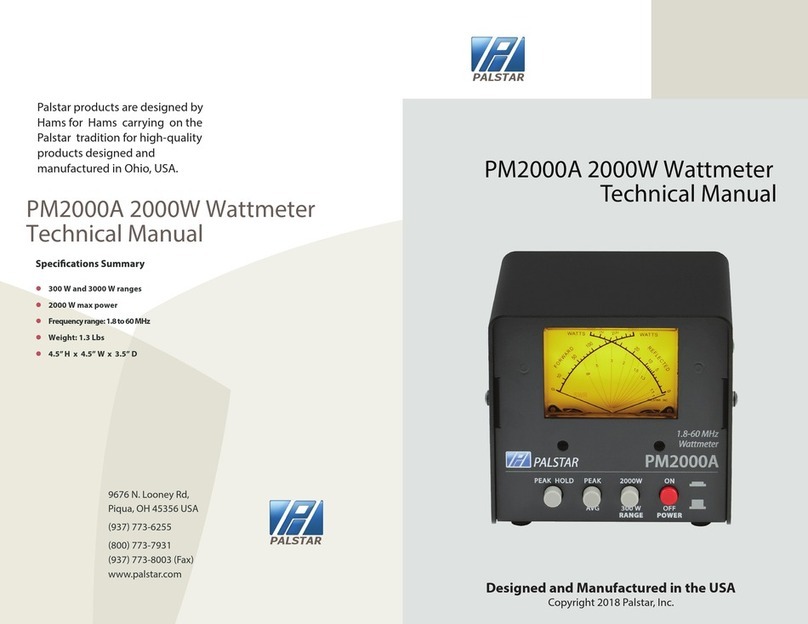
Palstar
Palstar PM2000A Technical manual
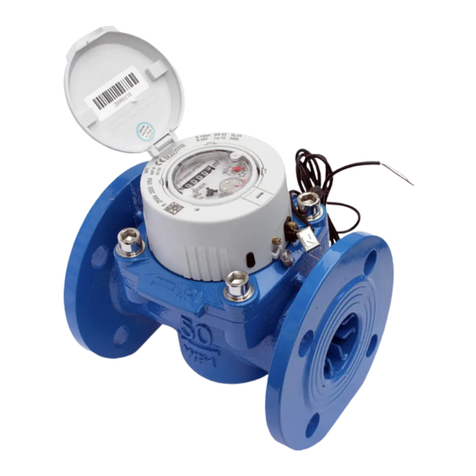
Zenner
Zenner WSD installation instructions

ANALOX
ANALOX 1371 MK2 instruction manual
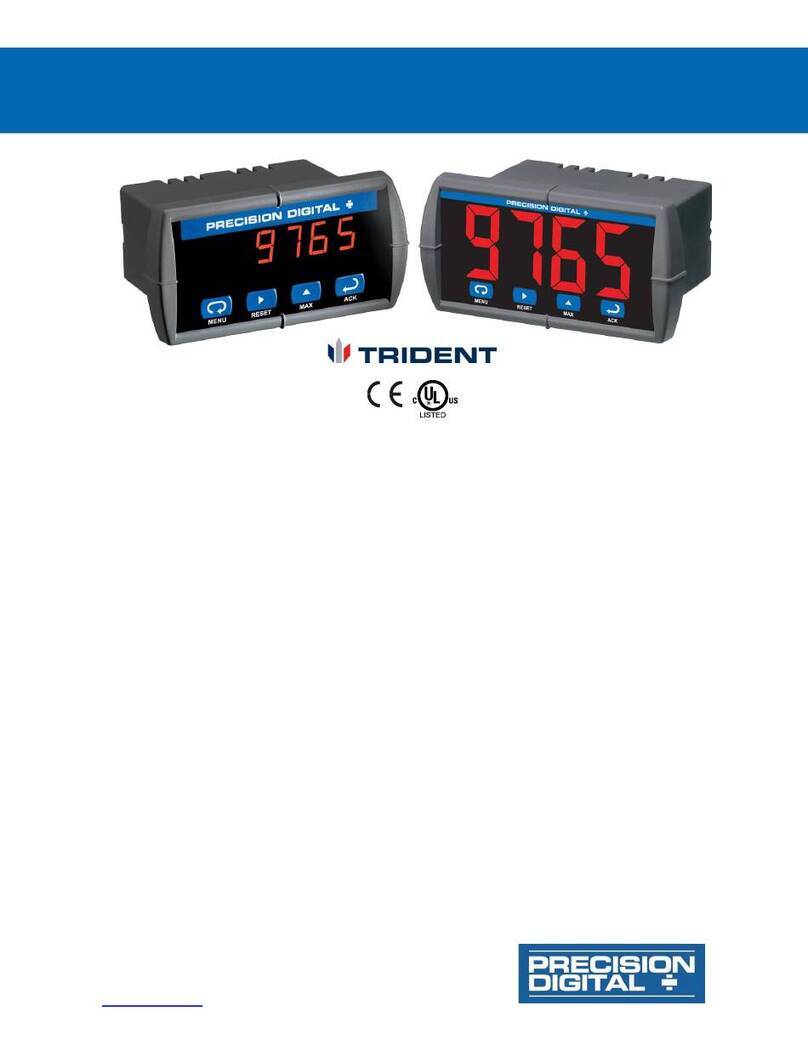
Precision Digital Corporation
Precision Digital Corporation Trident Series instruction manual
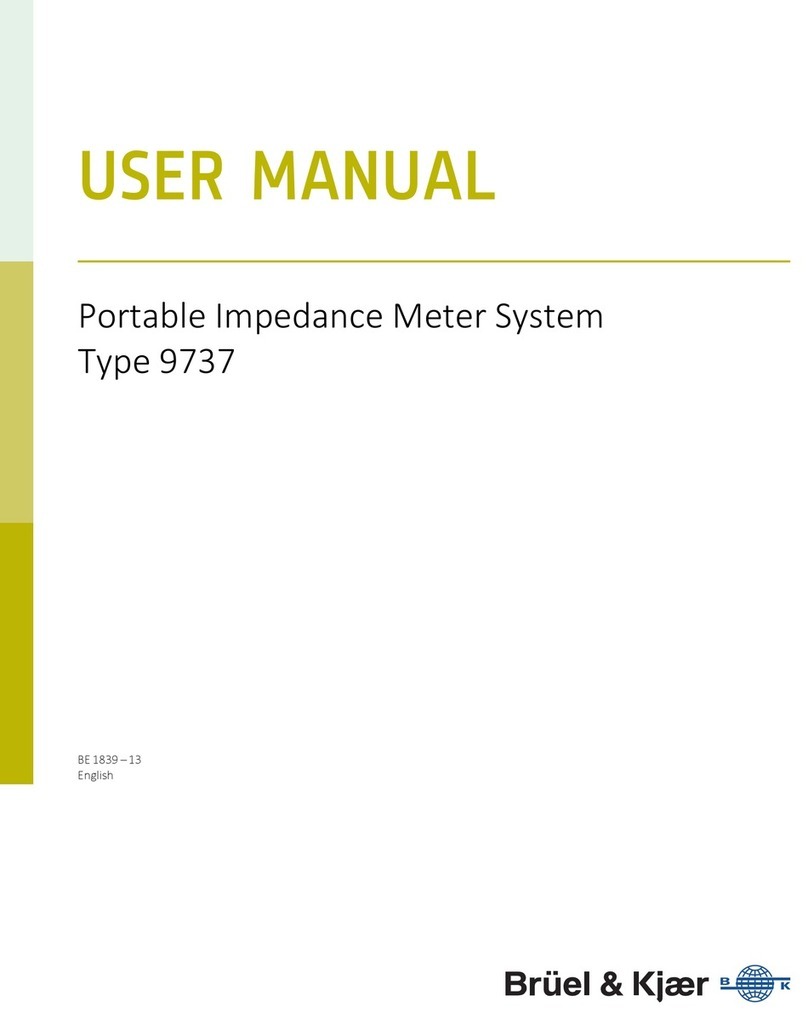
BRUEL & KJAER
BRUEL & KJAER 9737 user manual
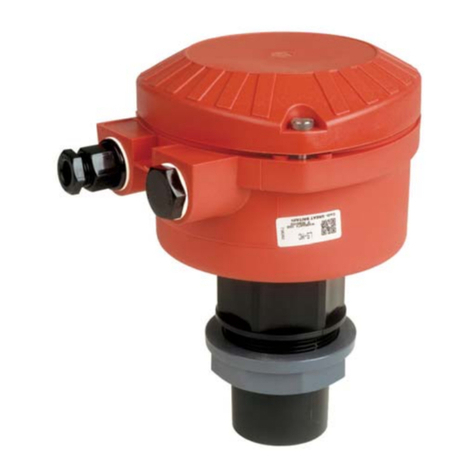
Sontay
Sontay LS-MC installation instructions
